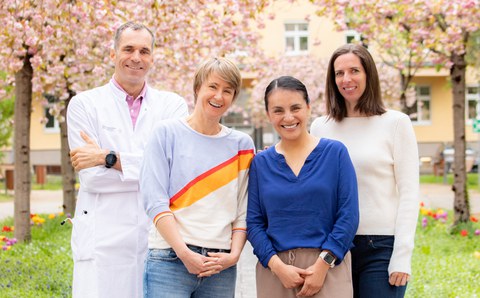Rolle des Eisenstoffwechsels in der osteohepatischen Achse - FerrOs (FOR 5146)

Die Dresdner Projektgruppe von „FerrOs“ (v.l.n.r.): Prof. Lorenz Hofbauer, PD Ulrike Baschant, Dr. Maria Ledesma-Colunga und Projektleiterin Prof. Martina Rauner
Seit 2021 koordiniert Prof. Martina Rauner die Forschungsgruppe „FerrOs“. Die Förderung durch die DFG ermöglicht den Wissenschaftlerinnen und Wissenschaftlern der Medizinischen Fakultät der TU Dresden und des Universitätsklinikums Carl Gustav Carus gemeinsam mit Arbeitsgruppen aus Heidelberg und Köln, den Mechanismen zur Feinabstimmung der Eisenregulation und den molekularen Zusammenhängen zwischen Leber und Knochen weiter auf den Grund zu gehen.
Die Leber als zentrales Organ für die Eisenhomöostase, also die Aufnahme, Verteilung und das Ausscheiden von Eisen, hält den systemischen Eisenspiegel in dem engen Bereich, der für die menschliche Gesundheit optimal ist. Treten ernährungsbedingt oder aufgrund von chronischem Blutverlust Eisenmangel bzw. aufgrund von hämatologischen oder genetischen Störungen Eisenüberladung auf, wirkt sich das negativ auf die Knochen aus.
„In den einzelnen Projekten untersuchen wir, wie die Aufnahme, der Transport und die Verteilung von Eisen im Organismus kontrolliert werden, welche zellulären Notprogramme gegen zu wenig oder zu viel Eisen schützen und welche Auswirkungen bestimmte Störungen dieser Regulation auf Krankheits- und Alterungsprozesse haben“, erläutert Martina Rauner: „Unser Ziel ist es, neue Einblicke in die Mechanismen eisenbedingter Erkrankungen zu gewinnen und neuartige duale Therapien zu entwickeln, die gleichzeitig auf die Vorbeugung und die Behandlung von Knochen- und Lebererkrankungen abzielen.“
Weitere Informationen zu den wissenschaftlichen Teilprojekten, den gemeinsamen Publikationen oder den beteiligten Wissenschaftlerinnen und Wissenschaftlern finden Sie auf der Projektwebsite zu FerrOs.
